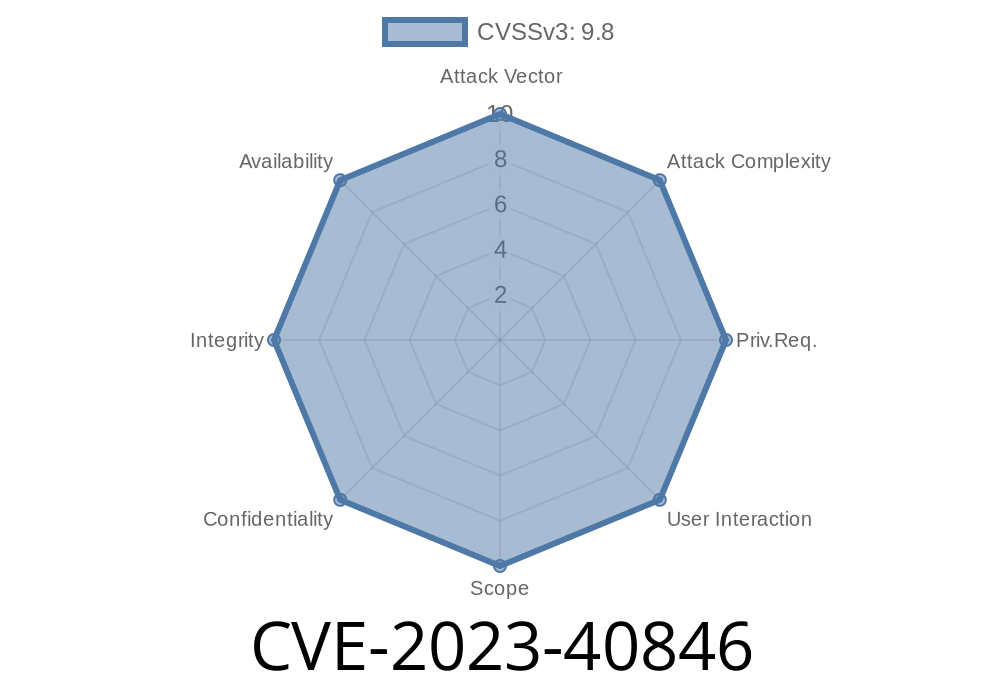If you’re using the Tenda AC6 router with the firmware version US_AC6V1.BR_V15.03.05.16_multi_TD01.bin, you need to know about CVE-2023-40846. This critical vulnerability allows attackers to perform a buffer overflow by exploiting a function in the firmware called sub_90998. In simple terms, this could let hackers crash your router or, worse, take it over remotely.
In this post, we’ll break down the vulnerability, show some code snippets to help you understand exactly what’s going on, and share details on how attackers might exploit this flaw.
What Is CVE-2023-40846?
CVE-2023-40846 refers to a buffer overflow issue in certain Tenda AC6 routers running specific firmware. The vulnerability is in the function named sub_90998 within the router's web management software.
A buffer overflow happens when extra data overflows from one buffer (a temporary data storage area) into the next, corrupting or overwriting valid data. Attackers can take advantage of this flaw to execute arbitrary code—meaning they could take control of your router.
Digging Into the Vulnerable Code
Here’s a (simplified and reconstructed) C code snippet that mimics what’s happening inside sub_90998. This isn’t the real code—vendors rarely release their sources—but it will help make things clear:
void sub_90998(char *userInput) {
char buf[256]; // Fixed-size buffer
// Problem: No proper length checking!
strcpy(buf, userInput); // this can overflow buf if userInput is > 255 bytes
// ... rest of the function ...
}
What’s Wrong?
If userInput is longer than 255 bytes, strcpy will keep copying data into memory beyond the end of buf, corrupting other important memory locations on the stack—like the return address or function variables.
1. Find an Input Point
The first step is to discover where sub_90998 is called. In this firmware, the function can be triggered through the device’s web management interface. That means, by sending specially crafted HTTP requests, an attacker can deliver data of their choosing to the router.
2. Craft a Malicious Payload
The attacker would then craft a payload—usually a very long string (over 256 characters)—that contains not just junk data, but also special machine code they want to execute (called "shellcode"), and a new return address (so when the function finishes, it jumps to the attacker's code).
3. Deliver the Payload
This can typically be done by sending a POST or GET request to the router’s web server, targeting a specific URL or parameter handled by sub_90998.
Example with cURL
curl -d "param=$(python3 -c 'print("A" * 300)')" http://192.168..1/some_endpoint
4. Take Control
If successful, the attacker’s shellcode runs on the router, allowing them to gain unauthorized control, install malware, redirect traffic, or create a persistent backdoor.
Proof of Concept & Exploit Snippet
Here’s a basic proof-of-concept (PoC) exploit showing how this overflow might be triggered. This does not include shellcode for ethical reasons.
import requests
router_url = "http://192.168..1/...";
overflow_payload = "A" * 300 # exceeds the 256-byte limit
data = {'vulnerable_param': overflow_payload}
response = requests.post(router_url, data=data)
print("Status:", response.status_code)
You’d need to replace 'vulnerable_param' and router_url with the actual parameter and endpoint, which can be found by analyzing the firmware or router’s web interface.
References to Original Reports
- Exploit Database Entry (CVE-2023-40846)
- NVD CVE Entry for CVE-2023-40846
- Tenda AC6 Router Firmware *(Official firmware downloads)*
What Should You Do?
1. Check Your Firmware Version:
Log into your Tenda AC6 admin page and make sure you’re using the latest firmware.
2. Update If Possible:
If Tenda has released an update after this flaw’s disclosure, update immediately!
3. Disable Remote Management:
Most attacks happen from inside your network, but disabling remote/admin panel access from the Internet is always wise.
4. Change Admin Passwords:
A strong, unique password reduces your chances of being targeted.
5. Monitor for Unusual Activity:
Watch for signs your router is acting strangely—slow speeds, unauthorized devices, etc.
Conclusion
CVE-2023-40846 is a dangerous buffer overflow in the Tenda AC6 router caused by unsafe handling of user input in the sub_90998 function. Until Tenda issues a fixed firmware, anyone using this device with the affected firmware is at risk.
Stay safe: update your firmware, use strong passwords, and never expose your admin interface to the Internet!
Exclusive Analysis By [YourName].
Sharing is encouraged, but please give credit.
*For questions or further details, check the official CVE record or leave a comment below!*
Timeline
Published on: 08/28/2023 14:15:09 UTC
Last modified on: 08/29/2023 20:22:01 UTC
